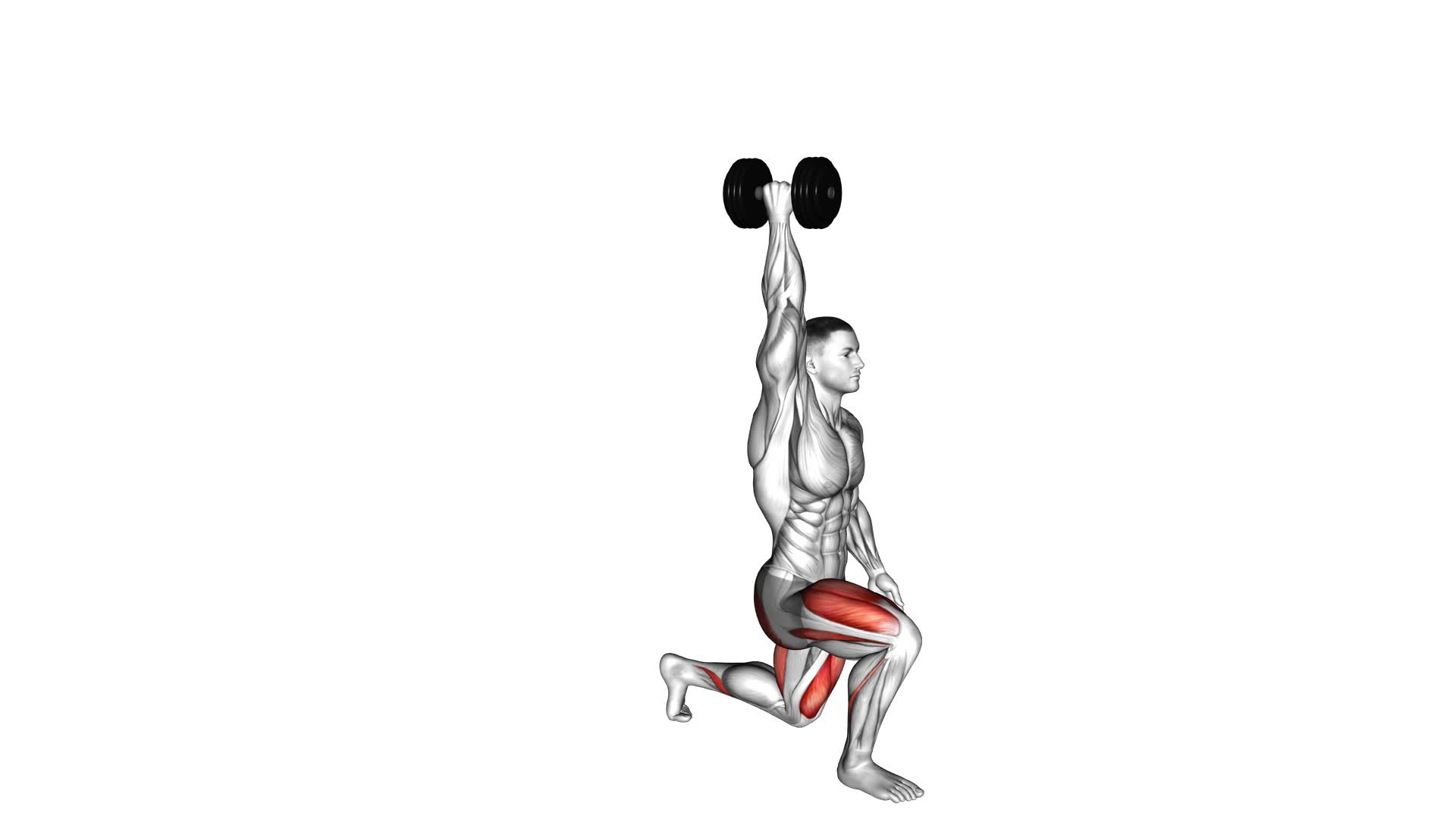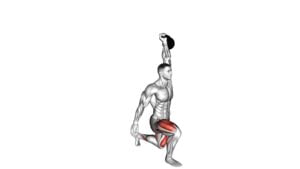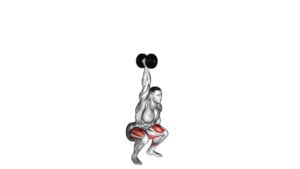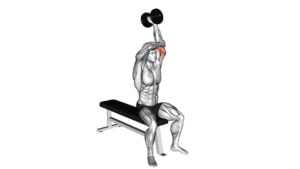Dumbbell Single Arm Overhead Lunge – Video Exercise Guide & Tips

Are you looking to level up your workout routine?
Watch This Exercise Video
Then the dumbbell single arm overhead lunge is for you!
This exercise targets your legs, core, and shoulders, all in one powerful move.
In this video exercise guide, we'll show you the proper form and technique, the benefits of this exercise, variations to increase difficulty, and tips for a safe and effective workout.
Get ready to challenge yourself and take your fitness to new heights!
Key Takeaways
- Maintain a stable core and avoid extending the knee beyond the toes
- Keep the shoulders square and chest lifted
- Engage the core and protect the joints
- Gradually increase resistance and try different variations to increase difficulty
Proper Form and Technique
To perform the Dumbbell Single Arm Overhead Lunge with proper form and technique, you should maintain a stable core and ensure that your knee doesn't extend beyond your toes. This exercise is a great way to target your lower body and improve your overall strength and stability.
One common mistake people make when performing this exercise isn't maintaining proper alignment. It's important to keep your shoulders square and your chest lifted throughout the movement. This will help to engage your core and keep your body in the correct position.
Another common mistake is allowing your knee to extend beyond your toes. This can put unnecessary strain on your knee joint and increase the risk of injury. To avoid this, focus on keeping your knee in line with your ankle throughout the lunge. This will help to maintain proper alignment and protect your joints.
In addition to these common mistakes, it's also important to remember to breathe throughout the exercise. Inhale as you lower into the lunge and exhale as you push back up to the starting position. This will help to stabilize your core and provide the necessary oxygen to your muscles.
Benefits of the Dumbbell Single Arm Overhead Lunge
The Dumbbell Single Arm Overhead Lunge offers a multitude of benefits for your lower body strength and stability. Incorporating this exercise into your workout routine can yield significant advantages for your overall fitness.
One of the key benefits of the dumbbell overhead lunge is its ability to target multiple muscle groups simultaneously. By holding a dumbbell overhead with one arm while performing lunges, you engage your core, glutes, quadriceps, hamstrings, and calf muscles. This exercise helps to improve your lower body strength, making it an excellent choice for athletes and fitness enthusiasts looking to enhance their performance.
Additionally, the single arm overhead lunge challenges your stability and balance. By performing lunges with a weight held overhead, you activate your stabilizer muscles, which play a crucial role in maintaining good posture and preventing injuries.
Another advantage of the dumbbell single arm overhead lunge is its versatility. You can easily adjust the weight of the dumbbell to suit your fitness level and gradually increase the resistance as you get stronger. This exercise can be modified to suit different fitness goals, whether you're aiming for muscle hypertrophy or fat loss.
Variations to Increase Difficulty
To increase the difficulty of the dumbbell single arm overhead lunge, you can incorporate various variations into your workout routine. Here are some progression options and advanced modifications to challenge yourself even further:
- Increase the weight: As you become stronger, gradually increase the weight of the dumbbell to intensify the exercise.
- Add a balance challenge: Perform the lunge on an unstable surface, such as a Bosu ball or a balance board, to engage your core and improve stability.
- Alternatively, you can try a single leg overhead lunge, where you keep one foot elevated off the ground throughout the movement.
- Incorporate explosive movements: Instead of performing a static lunge, explosively push off the ground and switch legs mid-air, landing in a lunge position with the opposite leg forward.
- You can also try performing a jump lunge, where you explosively jump into the air and switch legs mid-air before landing in a lunge position.
By incorporating these progression options and advanced modifications, you can continue challenging your muscles and taking your dumbbell single arm overhead lunges to the next level.
Now, let's move on to the next section for some tips on how to ensure a safe and effective workout.
Transitioning into the subsequent section about 'tips for a safe and effective workout', it's important to maintain proper form and listen to your body to avoid injury and maximize the benefits of your exercise routine.
Tips for a Safe and Effective Workout
For a safe and effective workout, prioritize proper form and listen to your body's cues. This is crucial for preventing injuries and maximizing results.
When performing the Dumbbell Single Arm Overhead Lunge, it's important to maintain a stable core and engage your glutes and quads throughout the movement. Keep your back straight and avoid leaning too far forward or backward. This will help prevent strain on your lower back and knees.
As you lunge forward, make sure your front knee stays aligned with your ankle, and your back knee hovers just above the ground.
Be mindful of any discomfort or pain during the exercise. If you experience any sharp or intense pain, stop immediately and consult with a healthcare professional.
By paying attention to your form and listening to your body, you can ensure a safe and effective workout.
Now, let's move on to the next section and discuss the common mistakes to avoid when performing the Dumbbell Single Arm Overhead Lunge.
Common Mistakes to Avoid
When performing the Dumbbell Single Arm Overhead Lunge, be cautious of these common mistakes to avoid:
- Using too much weight: One common mistake people make is using weights that are too heavy for them. This can lead to poor form and increase the risk of injury. Make sure to choose a weight that allows you to maintain proper form throughout the exercise.
- Allowing the knee to go past the toes: Another common mistake is allowing the front knee to go past the toes during the lunge. This can put excessive stress on the knee joint. Instead, focus on keeping your front knee in line with your ankle as you lunge down.
To improve your form and maximize the benefits of the Dumbbell Single Arm Overhead Lunge, try the following:
- Start with lighter weights: If you're new to this exercise, start with lighter weights and gradually increase the load as you build strength and confidence.
- Engage your core: To maintain stability and balance, engage your core muscles throughout the exercise. This will help you keep a neutral spine and prevent excessive forward or backward leaning.
Frequently Asked Questions
How Many Sets and Reps Should I Do for the Dumbbell Single Arm Overhead Lunge?
To progress the dumbbell single arm overhead lunge, you should start by determining the appropriate number of sets and reps for your fitness level. Gradually increase the intensity by adding more weight or performing more reps.
This exercise has numerous benefits, such as improving core stability, leg strength, and shoulder mobility.
Can I Use a Kettlebell Instead of a Dumbbell for This Exercise?
Yes, you can use a kettlebell as a substitute for a dumbbell in the single arm overhead lunge exercise.
This variation offers similar benefits to the dumbbell version, such as improved core stability, leg strength, and shoulder mobility.
Holding the kettlebell overhead challenges your muscles in a different way, adding variety to your workout routine.
Remember to maintain proper form and control throughout the exercise to maximize its effectiveness.
Is It Better to Do This Exercise on a Flat Surface or an Elevated Platform?
To get the most out of the dumbbell single arm overhead lunge, it's important to consider the surface you're working on.
Both flat surfaces and elevated platforms have their benefits and variations. On a flat surface, you'll focus on stability and balance, while an elevated platform adds an extra challenge by increasing the range of motion.
Ultimately, it's up to you to decide which option aligns with your fitness goals and abilities.
Should I Keep My Core Engaged During the Entire Exercise?
Yes, it's important to keep your core engaged during the entire exercise. This helps to stabilize your body and maintain proper form. Engaging your core also activates your abdominal muscles, making the exercise more effective for strengthening your core.
By keeping your core engaged, you're able to control your movements and prevent any unnecessary strain on your lower back.
Can I Do This Exercise if I Have Knee or Back Pain?
If you have knee or back pain, modifications can be made to the dumbbell single arm overhead lunge. Instead of lunging forward, you can perform a stationary lunge by keeping your feet planted and bending your knees.
Another alternative is to perform a reverse lunge, stepping backward instead of forward. These modifications can help alleviate stress on your knees and back while still engaging your muscles.
Always listen to your body and consult with a healthcare professional if needed.
Conclusion
In conclusion, the dumbbell single arm overhead lunge is an effective exercise for building strength and improving balance. By maintaining proper form and technique, you can reap the benefits of this exercise, including increased core stability and leg muscle activation.
To increase the difficulty, try incorporating variations such as adding weight or performing the exercise on an unstable surface. Remember to always prioritize safety by listening to your body and avoiding common mistakes.
Stay consistent and enjoy the rewards of a safe and effective workout.

Author
Years ago, the spark of my life’s passion ignited in my mind the moment I stepped into the local gym for the first time. The inaugural bead of perspiration, the initial endeavor, the very first surge of endorphins, and a sense of pride that washed over me post-workout marked the beginning of my deep-seated interest in strength sports, fitness, and sports nutrition. This very curiosity blossomed rapidly into a profound fascination, propelling me to earn a Master’s degree in Physical Education from the Academy of Physical Education in Krakow, followed by a Sports Manager diploma from the Jagiellonian University. My journey of growth led me to gain more specialized qualifications, such as being a certified personal trainer with a focus on sports dietetics, a lifeguard, and an instructor for wellness and corrective gymnastics. Theoretical knowledge paired seamlessly with practical experience, reinforcing my belief that the transformation of individuals under my guidance was also a reflection of my personal growth. This belief holds true even today. Each day, I strive to push the boundaries and explore new realms. These realms gently elevate me to greater heights. The unique combination of passion for my field and the continuous quest for growth fuels my drive to break new ground.







